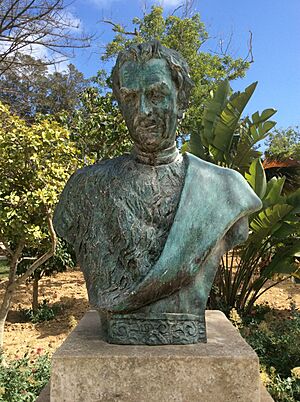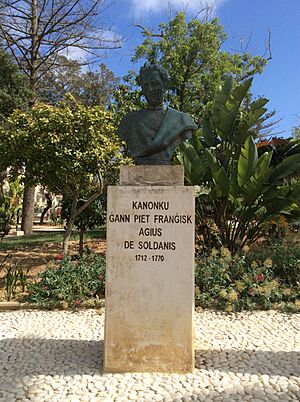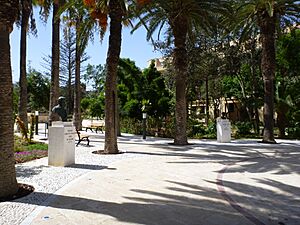Giovanni Pietro Francesco Agius de Soldanis facts for kids
Quick facts for kids
Giovanni Pietro Francesco Agius de Soldanis
|
|
|---|---|

Bust of de Soldanis at the Villa Rundle gardens
|
|
| Born |
Ġan Piet Franġisk Agius
1 November 1712 |
| Died | 30 January 1770 (aged 57) |
| Resting place | Collegiate Parish Church of St Paul's Shipwreck, Valletta |
| Nationality | Maltese |
| Education | Collegium Melitense, Valletta University of Padua |
| Occupation | Priest · Lawyer · Librarian |
| Parents |
|
Giovanni Pietro Francesco Agius de Soldanis (born October 30, 1712 – died January 30, 1770) was an important person from the island of Gozo, Malta. He was a linguist (someone who studies languages), a historian (someone who studies the past), and a cleric (a religious leader). People often called him just de Soldanis. He created the first dictionary and grammar rules for the Maltese language. He also became the first librarian of the Bibliotheca Publica, which later became the National Library of Malta.
Contents
Life of de Soldanis
De Soldanis was born on November 1, 1712, in a town called Rabat on the island of Gozo. His parents were Andrea Hagius and Valenzia Sultana. He was baptized the next day at the Parish Church of St. George. His birth name was Giovanni Pietro Francesco Agius. Later, he added de Soldanis to his name. This part came from his mother's family name, Sultana, but in a Latin style.
De Soldanis first learned at home from a Capuchin friar. Later, he studied many subjects at the Collegium Melitense in Valletta. These subjects included literature, philosophy, theology, and law. In 1729, he became a canon of the main church in Gozo. This was a special role given by Bishop Paul Alphéran de Bussan. Six years later, in 1735, he became a priest.
De Soldanis loved learning about history, culture, and the Maltese language. He had a huge collection of books in his home. He also had a special room, like a small museum. It was filled with old coins, medals, writings, pottery, and statues. He wrote many books and papers in different languages. These included Maltese, Italian, and French. He published some of his works in other countries like Rome and Naples. He couldn't publish anything in Malta because there were no printing presses there at the time.
In 1753, he got an important job in Gozo. He became the official preacher for special church seasons like Advent and Lent. In the 1750s, de Soldanis traveled around Italy and France. During this time, he studied at the University of Padua and became a lawyer. He also joined several important academic groups in Italy.
De Soldanis came back to Gozo in 1758. But in 1763, he moved to mainland Malta. A knight named Louis Guérin de Tencin chose him for a very special job. He became the first librarian of the Bibliotheca Publica in Valletta. This library was the start of the National Library of Malta.
De Soldanis started to get sick in 1768. He passed away on January 30, 1770. He was buried in the Collegiate Parish Church of St Paul's Shipwreck in Valletta.
De Soldanis's Works
Maltese Language Studies
De Soldanis was very interested in the Maltese language. He wrote many works about it throughout his life. In 1750, he wrote the first grammar book for the Maltese language. He did this after hearing that a Portuguese knight wanted such a book. The book was called Della Lingua Punica presentemente usata da Maltesi. It was published in Rome. In this book, de Soldanis thought that Maltese came from the Punic language. He believed Punic came from the Etruscan language. However, later studies showed this was not true. Today, we know that Maltese comes from Siculo-Arabic.
From 1750 to 1762, de Soldanis worked on another grammar book. It was called Nuova Scuola della Lingua Punica, but it was never published. He also wrote a huge dictionary with four volumes. It was a Maltese-Latin-Italian dictionary. He worked on it between 1750 and 1767. This dictionary was also never published. But it is seen as his most important work about the Maltese language. It gives us a great look at how Maltese was spoken in the mid-1700s.
Other Writings
Besides his language studies, de Soldanis also wrote about history, archaeology, and other topics. These topics were all about Malta and Gozo. His most famous work is Il Gozo Antico-Moderno e Sacro-Profano. This was a two-volume book about the history of Gozo. He finished it in 1746. This book became the base for many other studies about Gozo. It was not published until 1936. Then, it was translated into Maltese. An English translation came out in 1999.
In 1751, de Soldanis published a book called Mustafà Bassà di Rodi schiavo in Malta. This book was about the Conspiracy of the Slaves. This event had happened two years earlier. This book caused problems for him with Grand Master Manuel Pinto da Fonseca. In the book, de Soldanis criticized the Order of St. John. He also argued for the rights of the Maltese people. De Soldanis had to go to Rome to explain himself to Pope Benedict XIV. But he returned to Malta in 1752 and was forgiven.
De Soldanis also wrote a series of dialogues. These are now important for understanding the language and culture of his time. Many of his works and papers are now kept at the National Library of Malta.
Remembering de Soldanis
A school in Victoria, Gozo, is named after him: Agius de Soldanis Girls' Junior Lyceum and Secondary School. It is the only girls' school in Gozo. It is also one of the biggest schools in Malta. You can find a statue of his head (a bust) in the Villa Rundle Gardens in Victoria.
In 2012, people celebrated 300 years since de Soldanis was born. There were special exhibitions and events in Victoria and Valletta. In 2013, a plaque was put up in his honor at St. George's Square in Victoria.



